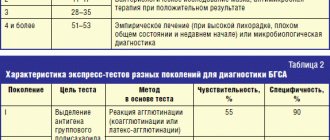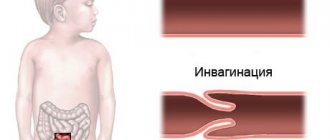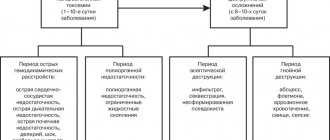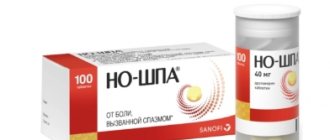Infographic: gastroenteritis
Each season has its own disease. In winter and autumn we are faced with the traditional cold season, in the spring people suffer from hay fever, and in the summer, especially in August, there is a peak in cases of gastroenteritis.
Gastroenteritis is inflammation of the mucous membranes of the intestines and stomach. It develops under the influence of toxins from viruses and bacteria that enter the body. Everyone has suffered from gastroenteritis at least once in their life. It occurs especially often in children under 5 years of age. The immune system of children is usually weaker than that of adults, which means that it is much easier for bacteria and viruses to penetrate a child’s body.
How does gastroenteritis occur?
The main causative agents of intestinal infections are viruses; they are responsible for approximately 70% of cases of gastroenteritis. Most often, the culprit is rotavirus, and in general almost two dozen different viruses can cause unpleasant symptoms.
Viruses spread through contact: you can become infected by touching objects or products that an infected person has touched. That is why you should not try unwashed peaches at the market or taste watermelon cut by the seller right on the counter.
About a third of cases of gastroenteritis are caused by bacteria. The most common causes of gastroenteritis are Salmonella, Campylobacter, Yersinia and Shigella. They enter the body when eating unwashed or spoiled foods. This happens much more often in the summer, because warm weather promotes the growth and spread of bacteria.
Bacteria that come into contact with a suitable nutrient medium - dairy products, meat, seafood - begin to actively multiply. Each cell divides once every 20 minutes. This means that every thousand bacterial cells turn into more than 30 million bacteria in 5 hours. The barbecue meat that you spent half a day defrosting in the sink, or the milk in the mug that you forgot on the veranda in the morning is literally teeming with germs.
Symptoms mild to severe
Diagnostics
Photo: beautymedicaltouch-usa.com
Most often in practice, infectious gastroenteritis occurs, the symptoms and diagnosis of which depend on the type of pathogen. However, the reason may also be the damaging effects of drugs and chemicals that are aggressive to the mucosa. Gastroenteritis is not an independent nosological entity and usually represents a symptom complex of manifestations of other diseases.
Diagnostic methods
Diagnosis of gastroenteritis consists of examining the patient, collecting an anamnesis of his disease, differential diagnosis with similar pathologies, and the use of laboratory and instrumental research methods.
As a rule, diagnosis of gastroenteritis can be made based on examination and complaints of the patient. Signs of gastroenteritis can vary in severity. It all depends on the nature of the disease, its etiology, severity, age of the patient, and concomitant pathologies.
The disease manifests itself suddenly.
Patient's complaints
The main complaints are as follows:
- lack of appetite;
- weight loss;
- nausea, vomiting;
- rumbling in the abdomen;
- pain of varying intensity of a spastic nature;
- diarrhea of various types;
- muscle pain;
- general severe weakness;
- feeling of bloating;
- temperature increase.
Diarrhea may be absent, but this does not exclude the presence of rumbling in the abdominal cavity, which is one of the specific features of this disease, which facilitates the diagnosis of gastroenteritis.
Vomiting and diarrhea can be so significant that they sometimes provoke dehydration with corresponding manifestations: decreased blood pressure, increased heart rate, and renal failure.
Increased temperature: it can vary from low-grade to high, depending on the pathogen.
Features of the disease depending on the pathogen
With viral etiology, the main manifestation of gastroenteritis is loose to watery stools. Rarely there are mucus or blood impurities.
Rotavirus causes significant intoxication. The temperature is often low-grade, but can sometimes rise to high levels. Vomiting is typical. The acute period lasts about a week.
Caliciviruses are characterized by an acute onset of the disease with severe vomiting and spasmodic pain of significant intensity. Vomiting is more pronounced in children, and diarrhea in adults. Often all this is accompanied by headache and muscle pain. This period does not last long - 1-2 days.
Under the influence of adenoviruses, the disease lasts a long time - 2-3 weeks. Vomiting is not expressed. Begins 1-2 days after diarrhea. In half of the cases, an increase in temperature is observed, but rarely to high levels.
Bacterial gastroenteritis is accompanied by severe intoxication symptoms: high fever, severe general weakness. Severe diarrhea, accompanied by bleeding. Some bacteria synthesize large amounts of enterotoxin, which causes profuse, watery stools.
Parasites do not cause acute symptoms. As a rule, gastroenteritis caused by them develops with mild diarrhea. Blood in the stool is rare. Only for amoebic dysentery. Characterized by severe general malaise and weakness.
Differential diagnosis
Differential diagnosis is carried out by analogy with acute diseases of the abdominal organs (appendicitis, ulcerative colitis, cholecystitis).
Gastroenteritis is supported by watery diarrhea, consumption of potentially contaminated food, and the presence of the disease in others.
Stool examination
The attending physician determines what tests should be taken if gastroenteritis is suspected. A rectal examination is performed. Feces with gastroenteritis are indicative. If blood and watery diarrhea persist for more than a couple of days, a test is carried out for occult blood, for the content of parasites and their eggs in the feces, and a bacterial culture is carried out.
An enzyme-linked immunosorbent method can be used to determine the presence of lamblia and some viruses. However, such studies are carried out only in the event of a disease outbreak.
All patients who have bloody diarrhea must be tested for the presence of E. coli.
If bloody diarrhea occurs in adult patients, sigmoidoscopy is performed. In this case, a biopsy is taken and culture of the contents is taken to test the blood for gastroenteritis.
General tests for acute gastroenteritis
General blood tests for this pathology are not very specific. A general blood test for gastroenteritis can reveal inflammatory manifestations and an increase in the level of eosinophils. In severe cases, the number of electrolytes may change, which requires their correction.
Diagnosis, as well as treatment, should only be carried out by a specialist. Self-diagnosis can lead to erroneous diagnoses and, consequently, complications.
How is hemorrhagic gastroenteritis diagnosed?
Diagnosing the disease is quite difficult and sometimes requires an intestinal biopsy. Some causes of hemorrhagic gastroenteritis may include: stomach or intestinal ulcers, injury, tumors or blockages in the gastrointestinal tract, foreign bodies, infectious diseases such as canine parvovirus and bleeding disorders. To evaluate the condition, a blood test, coagulation test, stool test, or endoscopic examination of the gastrointestinal tract usually should be performed.
In dogs with hemorrhagic gastroenteritis, the hematocrit (proportion of red blood cells) is usually 60%. In most dogs it is from 37% to 55%. An elevated hematocrit, combined with a low or normal total solids content, is an important sign that the dog has hemorrhagic gastroenteritis. When diagnosed, they often try to eliminate bloody stools and gastrointestinal upset.
Treatment
Therapy for the disease must be comprehensive.
Symptomatic treatment:
Therapy for the disease must be comprehensive
Treatment of the root cause:
- use of broad-spectrum antibiotics , anthelmintic and antiprotozoal, antiviral drugs (depending on the source of infection);
- cleansing the body of toxins and toxic substances (in case of poisoning);
- feeding with good quality food (if there is a lack of nutrition);
- removal of foreign bodies (in case of intestinal blockage);
- prescribing antihistamines (for allergies).
Self-treatment of gastroenteritis in a dog and prescribing drug therapy is unacceptable.
Therapy is a complex and lengthy process even for an experienced veterinarian. Incorrect treatment can aggravate the situation and lead to the death of the animal.
Literature
- Kosek M., Bern C., Guerrant R.L. The global burden of diarrhoeal disease, as estimated from studies published between 1992 and 2000 // Bull. World Health Organ. 2003. Vol. 81. No. 3. P. 197–204.
- Kapustin D.V., Khokhlova N.I. et al. Modern aspects of acute gastroenteritis of viral etiology. Journal of Siberian Medical Sciences. 2019; 2: 107-117.
- ICD 10 - International Classification of Diseases, 10th Revision https://mkb-10.com/index.php?pid=10238
- Ploskireva A.A., Gorelov A.V. Algorithm for the treatment of acute intestinal infections in children. Attending doctor. 2016; 3 https://www.lvrach.ru/2016/03/15436428
- Khokhlova N.I., Krasnova E.I. et al. Acute intestinal infections of viral and bacterial etiology in children: modern diagnostic and therapeutic options, the role of metabiotics. Attending doctor. 2018; 6 https://www.lvrach.ru/2018/06/15437003
- Acute diarrhea in adults and children: a global perspective. Global practical recommendations of the World Gastroenterological Organization. February 2012; 27 p.
- A. Guarino, I.N. Zakharova, N.G. Sugyan Management of children with acute gastroenteritis in the pediatric area (ESPGHAN-2014 Recommendations) // MEDICAL COUNCIL • No. 01, 2016 P.148-156.
- M.A. Osadchuk, A.A. Uryupin, M.M. Osadchuk, V.O. Burdin Diarrhea in therapeutic practice // RMJ No. 15, 2014 P.1112-1119.
- L. Butorova, M. Kalashnikova, N. Krainikova, M. Osadchuk Management of patients with acute diarrhea at the outpatient stage // VRACH 10, 2015 P.78-84.
- Acute intestinal infections in the practice of a local pediatrician and therapist: a textbook for the system of additional professional education of doctors / S. N. Orlova, V. F. Balikin, N. N. Shibacheva, E. N. Kopysheva, A. A. Ryabchikova , O. R. Varnikova, I. V. Tezikova, S. E. Lebedev - Ivanovo: State Educational Institution of Higher Professional Education IvSMA Roszdrav, 2011. - 102 p.
- Yushchuk N.D., Andreev D.N., Kucheryavyi Yu.A. Acute diarrhea in adults: relevance of the problem and new treatment options // INFECTIOUS DISEASES: news, opinions, training No. 4 2017 P. 99-107.
- Roitberg G.E. Internal illnesses. Digestive system: textbook. allowance / G.E. Roitberg, A.V. Strutynsky. – 5th ed., revised. and additional – M.: MEDpress-inform 2007 —560 p.
- Instructions for use IMODIUM ® Express lyophilisate tablets // Reg. number P N016140/01 RF GRLS. — https://grls.rosminzdrav.ru/Grls_View_v2.aspx?routingGuid=fdbc42af-4580-4ecd-93d8-2e9a965c707a&t= (access date: 01/16/2019)
Tips for those planning trips with young children
When a child visits a place where the climate or sanitary conditions are different from usual, the likelihood of gastroenteritis increases.
To reduce the risk of developing pathology, parents should pay special attention to food and drinks while traveling.
Travelers should drink bottled drinks or boiled water. They should avoid vegetables and fruits that they have not peeled themselves. Food should be eaten hot if possible. Raw or undercooked seafood poses a particular risk. Pools and other water recreation areas can also become contaminated.
Pharmaceutical prophylaxis is not generally recommended for previously healthy children or adults. However, travelers should carry azithromycin (< 16 years of age) or ciprofloxacin (> 16 years of age) and begin antimicrobial therapy if diarrhea develops.
Prevention of gastroenteritis in adults at home
Gastroenteritis in adults is a very unpleasant and dangerous disease that can be easily prevented if you follow a few simple rules:
- Be sure to follow the rules of personal hygiene - wash your hands thoroughly with soap before eating, after visiting the toilet, and also when coming home from the street;
- for cooking, use only clean dishes, and either wash all products thoroughly or heat-treat them (especially raw fish, meat, poultry and mushrooms);
- products must be fresh and stored in the refrigerator; when warm, pathogenic microorganisms begin to multiply in them (therefore, it is not recommended to buy pastries from hand or dine at roadside cafes);
- drink only clean, fresh water, do not collect it from reservoirs or suspicious wells - as a last resort, such water must be thoroughly boiled or disinfected with special tablets;
- also remember about the dangers of alcohol on the digestive system, be careful when working with chemicals, and carefully monitor what mushrooms and berries you collect.
Symptoms of gastroenteritis in adults
The symptoms of gastroenteritis directly depend on the causes of its occurrence, as well as the form of the disease - mild, moderate or severe.
In mild forms of gastroenteritis, vomiting and loose stools occur no more than three times a day, and the temperature does not rise. Sometimes there may be no vomiting at all. But this does not mean at all that it does not pose any danger - on the contrary, the disease can subside and become chronic.
With moderate severity, the temperature rises to 38.5 ° C, and vomiting and diarrhea become more frequent up to 10 times a day. The patient experiences severe pain and cramps in the abdomen. The vomit may be greenish in color, with pieces of undigested food, and the stool is foamy, liquid, and foul-smelling.
In the most dangerous - severe form of gastroenteritis, the temperature rises sharply to 40 ° C, vomiting and diarrhea practically do not stop (more than 15 times a day), and severe pain is accompanied by convulsions, loss of consciousness, and dehydration. Of course, in this case you need to urgently call an ambulance.
Is the disease dangerous for people?
Infectious gastroenteritis is transmitted to humans through casual contact.
Gastroenteritis of infectious origin poses a danger to humans. Viruses, bacteria and parasites are transmitted through household contact.
When treating a sick dog, a person must observe all necessary safety measures:
- wash your hands thoroughly after contact with animals;
- Don't let your dog into your sleeping area;
- on the recommendation of a veterinarian, disinfest the premises and thoroughly ventilate.
You should consult your veterinarian about specific preventive measures for each disease.
Risk groups and routes of transmission
Risk groups include dogs of all breeds equally.
In severe form, the disease occurs in puppies with an immature immune system. Viral gastroenteritis in young dogs is difficult to treat and often leads to death.
Weak and elderly animals are at risk
The disease is also extremely difficult for weakened and elderly animals to tolerate.
The modes of transmission of infectious gastroenterocolitis are contact.
Through feces and vomit, the virus and parasites from a sick dog enter the environment. Upon contact with the secretions of an infected animal, healthy ones become infected.
Household ways of transmitting the disease: through the dog’s saliva and secretions.










